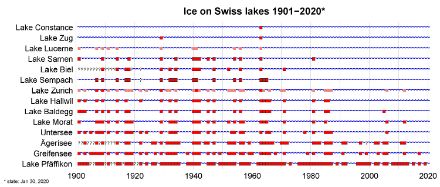Service Navigation
Search
In harsh winters, ice can form on Swiss lowland lakes, attracting public attention when they become safe to walk on. We outline below various aspects of the climate as they relate to the freezing over of lakes.
No systematic record keeping
There is no systematic record-keeping relating to ice on Swiss lakes. Nevertheless, there are groups and individuals who have been collecting data over a long period relating to ice on their lakes. Media archives also provide important information on the subject. In 2008, Hendricks Franssen and Scherrer published their data on ice in Swiss lowland lakes, and data are now available up to 2020, which affords deeper insights into the climatology of the phenomenon.
Definition of a frozen lake, or “Seegfrörni”
“Seegfrörni” is the Swiss word for a frozen lake that was used by Hendricks Franssen and Scherrer in their 2008 publication. We will also use this term here. According to the authors’ definition, a Seegfrörni is a lake that is completely or almost completely covered in ice for more than a day. In contrast to other definitions, this one does not require the ice to be thick enough to carry a person’s weight.
When does a lake freeze over?
Lakes react in different ways to cold. Simply put, the deeper a lake, the more coldness is needed before it freezes over. This is because the entire water mass of the lake has to be cooled to around 4°C before the water masses at or near the surface can be cooled further and make freezing over possible. So-called freezing degree days (FDD) have proven to be a simple and effective way of ascertaining the level of coldness that was needed for a lake to freeze over. For the calculation, the degrees Celsius of the days with a mean temperature below freezing are added together. So, one day with a mean temperature of -5°C gives a value of 5 FDDs. Every lake has its own FDD number that is reached before it freezes over. Figure 1 provides an overview of several lakes on the Swiss plateau. Important: The number of FDDs required for a Seegfrörni can fluctuate widely. The Greifensee, for instance, froze over one year at around 100 FDD, whereas in another year, not even 200 FDD was enough to achieve a Seegfrörni. An important factor here is the weather pattern from the previous summer through to the winter in question.
| Lake | FDD in | mean FDD | FDD range | No. of Seegfrörnen |
| Lake Pfäffikon | Zurich/Fluntern | 89 | 55‒147 | 86 |
| Lake Murten | Neuchâtel | 132 | 91‒191 | 30 |
| Greifensee | Zurich/Fluntern | 149 | 101‒220 | 53 |
| Lake Biel | Neuchâtel | 172 | 122‒244 | 15 |
| Untersee (Lower Lake Constance) | Güttingen | 170 | 128‒228 | 36 |
| Lake Baldegg | Lucerne | 174 | 131‒232 | 28 |
| Lake Hallwil | Lucerne | 174 | 134‒225 | 25 |
| Obersee (Upper Lake Zurich) | Zurich/Fluntern | 188 | 147‒240 | 36 |
| Lake Sempach | Lucerne | 216 | 144‒325 | 17 |
| Lake Sarnen | Lucerne | 222 | 160‒309 | 15 |
Figure 1: Coldness required for complete freezing over of ten Swiss lakes. The table shows the mean number of freezing degree days (FDD) and the FDD range within which a freezing over was observed in the period of 1901–2006 (from Hendricks Franssen and Scherrer, 2008). It also shows the number of observed Seegfrörni in the 1901–2020 period.
Considerably fewer Seegfrörnen
In recent decades, there has been a dramatic reduction in Seegfrörnen, as Figure 2 clearly shows. The biggest reductions are seen in medium-sized lakes, such as Lake Hallwil and Lake Sempach. Up until the 1960s, these two lakes used to freeze over between twice and four times in a decade. Since that time, with the exception of the 1980s, Seegfrörnen have not occurred in these lakes. Although the reductions seen in smaller, lower-lying or higher-altitude lakes such as Lake Pfäffikon, Greifensee or Lake Ägeri have been less dramatic; here too, the Seegfrörnen have become a much rarer phenomenon. Large or deep lakes such as Lake Constance and Lake Zug very seldom freeze over, the last time being in the harsh winter of 1962/63. There are lakes that have never once frozen over in hundreds of years, including Lake Geneva, Walensee and Lake Lucerne.

Climate change explains the reductions
Switzerland’s temperatures have increased by two degrees Celsius in the last 150 years, and cold snaps have decreased considerably. As a Seegfrörni only occurs in a harsh winter, the phenomenon is very sensitive to climate warming and the absence of severe cold snaps. Thus, climate warming readily explains the dramatic reduction in occurrences of Swiss lowland lakes freezing over.
What will the future bring?
Climate change is set to continue. Depending on the scenario, temperatures are likely to increase by a further degree Celsius. Using a simple model, researchers at ETH Zurich, the University of Fribourg, the Jülich Research Centre and Academia Engiadina have calculated that medium-sized lakes on the Swiss plateau could continue to freeze over in extremely cold winters until 2050. After that, the possibility will become increasingly unlikely.